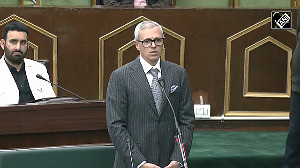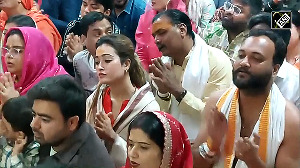Lintas India Group director Lynn De Souza kicked it off. In a recent magazine article, she said that TAM Media Research data represent just 38 per cent of India's television viewing homes.
De Souza later reiterated her point to Business Standard: "The sample is too small as 5,000 Peoplemeters is too little to extrapolate to 83 million TV homes."
That statement turned the arc lights on the validity of TAM Media Research data -- and kicked off a controversy in the broadcasting industry.
To put the rumpus in perspective, TAM Media Research, a venture among AC Nielsen, Kantar Media Research and Indian Market Research Bureau, has so far dominated the tracking of television viewing habits in India (it now has a competitor in aMap, a new TV audience measurement system that was set up last August).
It does this through Peoplemeters installed in television viewers' homes. TAM is hugely influential and its findings determine advertising on television channels.
Notes Rohit Gupta, executive vice president (advertising sales), Sony Entertainment Television: "TAM is the only currency used by the broadcasting industry. Over Rs 5,000 crore is spent based on its analysis."
But many now maintain that TAM data are inadequate. TAM is under attack -- for the limited size of its sample, for the absence of external auditing of TAM processes, the distribution of its Peoplemeters, for not covering the Hindi heartland properly and for inadequately reflecting Doordarshan's reach because of TAM's absence from rural India.
Some media men back De Souza's point about the small sample size. Says TV Today executive director G Krishnan: "A mere 5,000 Peoplemeters represent the entire universe of cable and satellite homes. This is a little difficult to digest."
Secondly, TAM covers 73 cities but towns with a population of less than 10 lakh (1 million) are not represented in the sample, despite the immense growth in rural India. Marketers argue that people beyond these towns are buying products.
Thirdly, Sony Entertainment Television's Gupta makes the point that TAM does not have an external auditor. "In my view, TAM's biggest flaw is the lack of auditing of its processes. If it says there are 5,000 meters in 73 towns, we have no way of knowing it. It must get a stamp of approval from an external auditor such as Ernst & Young or KPMG." Gupta says that today Jassi Jaisi Koi Nahin on Sony may get a TRP of 6.1, "but tomorrow I could ask who's audited it?"
Fourthly, media planners and marketing men at television channels grumble that TAM data do not represent affluent homes. Their contention: upmarket homes do not allow Peoplemeters to be installed as these intrude on privacy. Currently, TAM data are physically collected by people who visit homes with Peoplemeters every week.
"Even if it tempts them with foreign holidays, would high-income bracket households allow such intrusion of privacy," asks the head of ad sales at a bouquet of news channels. "Unlikely," replies Tapan Pal, chief executive officer at aMap, the new TV audience measurement system.
"That is why we've installed an online system where the server dials up the homes on the panel and automatically collects data from the meters every day between 2 am and 4 am."
aMap currently covers Delhi, Mumbai and Ahmedabad and plans to install meters in towns with a population of 10 lakh plus in Uttar Pradesh, Madhya Pradesh and Haryana soon. "By 2006, we hope to have 20,000 panel homes," Pal adds.
Fifthly, distribution teams at television channels contend that the meters are poorly distributed and tend to be concentrated in some cable networks in a city. So it's not difficult to find out where the meters have been installed (in short, confidentiality is compromised).
The head of ad sales at a broadcasting company says that switching off the cable head-ends one by one in a city "usually tells you the weightage every operator has in a market."
And once the distribution teams know where the meters are concentrated, the marketing teams swing into action. This makes targeted marketing possible.
Last, but not least, for the last three years TAM has been using National Readership Survey 2002 data for its research. For instance, it was depending on the old data on black and white TV households.
"As a result it used to automatically discount viewership on the hyperbands (the lower frequency bands which cannot be seen on B&W TVs)," an executive at a television channel complains. He believes that many B&W TV households would have upgraded to colour Tvs in the last three years, a trend not reflected in TAM data.
Still, De Souza herself is quick to add that the data and analysis provided for the 38 per cent homes is sound. "What TAM needs to do is to find ways to extend itself to the other 62 per cent."
TAM chief executive officer L V Krishnan says that TAM has never claimed that it represents the entire TV home universe. "We've maintained that we cover urban households in towns with a 10 lakh-plus population."
Also, the size of the sample is always decided in consultation with the joint industry body comprising the Advertising Agencies Association of India, the Indian Broadcasting Foundation and the Indian Society for Advertisers.
"We had proposed a sample size of 7,600 meters in the second phase of expansion. This was scaled down by the joint industry body. I don't see what the issue is," Krishnan exclaims.
TAM also says that it follows international benchmarks and carries out internal audits to maintain what it calls Gold Standards. These relate to key performance indicators in the arena of sampling, panel security, the technical compliance of the meters and so on.
Rising to TAM's defence, others make the point that India's cable TV viewership sample is among the largest in the world. Argues Times Global Broadcasting's CEO Sunil Lulla, who's been associated with various TAM committees in a personal capacity: "The US has 5,500 meters. If it's okay for it, it should be okay for us."
But Sony Entertainment's Gupta believes that that argument doesn't hold water. Unlike the United States, India with over a billion people, 19 religions, 17 languages and 844 dialects is far from being homogenous.
"With such diversity, nuances in viewership habits and attitudes can't be captured with 4500 plus meters. Today the challenge for marketers is not just the key towns. Extrapolation is extremely dangerous using the currently available data," says Gupta.
Also, television viewers in a city vary widely. "In Mumbai, a viewer in Dadar with the same demographic variables will be very different to a viewer in Malabar Hill," says G Krishnan. In the absence of a perfect system the entire targeting/segmenting exercise is reduced to a shot in the dark, he adds.
L V Krishnan disagrees. He says the TAM data capture the pulse of viewership behaviour. "Ideal measurement should respond to environment changes. And that is what it does."
He showcases a series of slides which reflect the changing viewership patterns on television channels during sports events or major news breaks.
TAM is also increasing its presence in affluent homes though Krishnan says it's a myth that upmarket households do not co-operate. "We are putting up booster elite panels and installing 300 online meters in Mumbai and Delhi," he says.
Nor has the confidentiality of homes on TAM's panel been compromised. "It is impossible that these people know which homes have meters. Security and confidentiality is ensured. All this is conjecture," says Krishnan.
He adds that only some in the broadcasting industry are cribbing. "When you are not doing well, the easiest party to blame is the one that makes the report card," he adds.
On NRS data, Krishnan says that TAM has started using data from the new NRS 2005 report. This will now be used for future research.
Krishnan says that TAM is, in a three-pronged expansion drive, bringing in digital meters, going into small towns and creating elite panel homes.
"Our expansion will be based on how direct-to-home (DTH) and broadband shapes up in the country. We realise that users want to dissect data in narrower viewer segments. There will be a necessity to increase samples in specific sub groups of the TV viewing population. It is the very obvious next step," says Krishnan.
But De Souza may have the last word. She states categorically that her statement was not meant to belittle TAM but raise the point that the broadcasting industry and others must pay more if they want a better and comprehensive data tracking system. A Star India spokesman agrees: TAM is doing its best with the means it has. Companies have to shell out more money if they want a better service."
| But where will the cash come from?
Broadcasters may complain about the small TV viewing households sample size, but increasing the number of Peoplemeter homes needs heavy investments. If TAM is to be believed, each imported meter costs $2,000. And the new digital meter will cost 50 per cent more, its executives claim. Off-the-record, media industry experts say that broadcasters face a Catch 22 situation. Not many users of TAM are willing to shell out more for the data. Major broadcasters are already paying Rs 2 crore a year for the report. The fee is less (between Rs 10 lakh and Rs 16 lakh) for advertising agencies as their revenues are smaller. "But we have to pay more for any additional data or analysis that TAM offers," says media consultant Sulina Menon. However, media expert and Lintas' director Lynn De Souza feels that the television industry needs to step in and invest in research: "Broadcasters are using TAM to sell their programming, to understand audiences and distribution. Why can't they pay more? How can the media agencies which earn peanuts continue to fund the service?" She thinks that within its budget constraints, TAM is doing a remarkable job. "The problem is that the industry expects them to feed a party of 50 people but gives it enough money to only feed five," she adds. But the distribution head at a news channel retorts: "TAM has a long client list and charges a hefty fee, especially of broadcasters. So money should not be an issue. Why should we keep paying more for the report?" |







 © 2025
© 2025